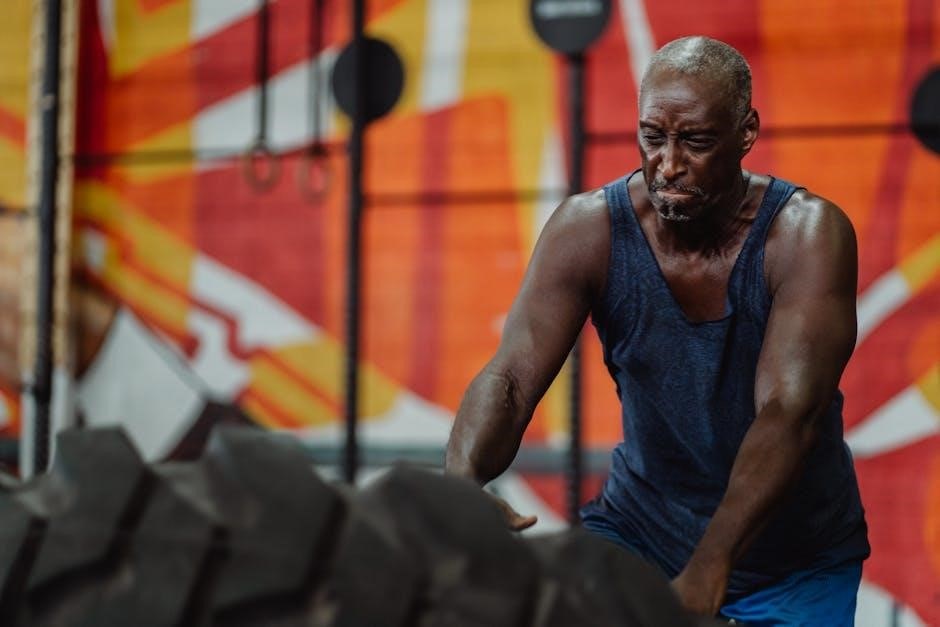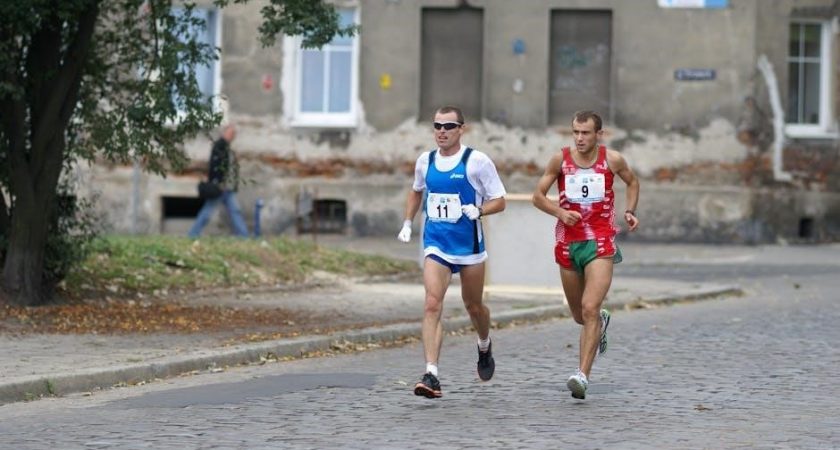This comprehensive 52-week Ironman training plan offers a structured approach to building endurance, nutrition, and mental resilience. Designed for consistency, it includes free PDF guides and resources to help athletes progress steadily toward race day.
Overview of the Plan

The 52-week Ironman training plan is a detailed, structured program designed to guide athletes from base fitness to peak race readiness. It emphasizes gradual progression, balancing endurance, strength, and recovery to avoid burnout. The plan is divided into phases, each focusing on specific goals, such as building aerobic endurance, increasing intensity, and simulating race conditions.
Key elements include weekly swim, bike, and run workouts, strength training, and nutrition strategies. The plan also incorporates high-intensity interval training (HIIT) and race-specific preparation. With a focus on consistency and execution, it provides a roadmap for athletes to achieve their Ironman goals. Free PDF guides and resources are available, offering flexibility and accessibility for triathletes at all levels. This comprehensive approach ensures athletes are physically and mentally prepared for the demands of a full-distance Ironman event.
Importance of Consistency and Execution
Consistency and execution are the cornerstones of the 52-week Ironman training plan. Regular, disciplined workouts ensure progressive overload, allowing the body to adapt and build endurance. Skipping sessions or inconsistent training can hinder progress and increase injury risk. Proper execution of each phase, from base building to taper, is critical for peak performance. The plan emphasizes balancing intense training with recovery to avoid burnout. Athletes must commit to following the structured schedule, including swim, bike, and run workouts, strength training, and nutrition strategies. By staying consistent and executing each phase diligently, athletes can maximize their fitness levels and confidently approach race day. This focus ensures they are physically and mentally prepared to tackle the demands of a full-distance Ironman event. Consistency and execution are what transform effort into results.
Key Components of the Plan
The 52-week Ironman training plan is designed to systematically build endurance, strength, and mental resilience. It includes structured swim, bike, and run workouts tailored to each phase, ensuring progressive overload. Strength training is integrated to enhance power and prevent injuries, while nutrition and recovery strategies are emphasized to optimize performance. The plan incorporates periodized phases, with weekly mileage and intensity adjustments to avoid plateaus. Race-specific workouts simulate real conditions, preparing athletes mentally and physically. Free PDF guides provide detailed schedules, injury prevention tips, and nutrition advice. Community support and online forums offer additional motivation and guidance. This holistic approach ensures athletes are fully prepared for the demands of a full-distance Ironman, focusing on long-term consistency and sustainable progress.

Understanding the 52-Week Structure
This 52-week plan is divided into four distinct phases: Base Building, Build, Peak, and Taper. Each phase focuses on specific endurance and intensity goals, ensuring gradual progression toward race readiness.
Breaking Down the Plan into Phases
The 52-week Ironman training plan is structured into four distinct phases, each tailored to build specific skills and endurance. The Base Building phase (weeks 1-12) focuses on establishing a strong aerobic foundation through consistent swim, bike, and run workouts. The Build phase (weeks 13-24) increases both volume and intensity, incorporating strength training and high-intensity interval sessions. Weeks 24-36 mark the Peak phase, where athletes maximize fitness levels and simulate race conditions. Finally, the Taper phase (weeks 37-44) reduces training volume to allow recovery while fine-tuning race-specific strategies. Each phase is designed to progressively prepare athletes for the demands of a full Ironman, ensuring a balanced approach to endurance, strength, and mental readiness.
Weekly Mileage and Progression
The 52-week Ironman training plan emphasizes gradual progression in weekly mileage to ensure athletes adapt without overtraining. Early weeks focus on building a consistent base, with swim, bike, and run sessions increasing in duration and intensity. The plan balances endurance with recovery, incorporating rest days and cross-training to prevent burnout. Weekly mileage is tailored to the athlete’s experience level, with novice plans starting at around 8-10 hours per week and progressing to 15-20 hours during peak phases. Strength training and high-intensity intervals are introduced strategically to enhance performance. The structured progression ensures athletes are race-ready while minimizing the risk of injury or fatigue, making it a sustainable path to completing a full Ironman.
Swim, Bike, and Run Focus Areas
The 52-week Ironman training plan prioritizes balanced development across swimming, cycling, and running. Swimming focuses on endurance and technique efficiency, with drills to improve stroke mechanics. Cycling emphasizes building aerobic stamina and muscular endurance through long rides and interval training. Running incorporates progressive mileage to enhance cardiovascular fitness and lactate threshold. Each discipline is periodized to ensure consistent improvement without overtraining. The plan also integrates strength training to support musculoskeletal health and prevent injuries. By balancing these focus areas, athletes develop a well-rounded fitness base, essential for tackling the demands of a full Ironman. The structured approach ensures gradual adaptation, making it suitable for both novice and experienced triathletes aiming to optimize performance and achieve their race goals.

Base Building Phase (Weeks 1-12)
This phase focuses on building a strong aerobic base through consistent training. It emphasizes endurance, stamina, and gradual progression in swim, bike, and run disciplines.
Building Aerobic Endurance
Building aerobic endurance is the cornerstone of the base-building phase. This involves low-intensity, long-duration workouts designed to enhance cardiovascular efficiency and muscular stamina. By focusing on zone 2 training, athletes improve mitochondrial density, increasing fat utilization and delaying fatigue. Consistency is key, with weekly swim, bike, and run sessions structured to gradually increase time and distance. Strength training and mobility exercises are also incorporated to support endurance gains and prevent injury. The goal is to create a robust foundation that allows athletes to handle the demands of more intense training in later phases. This phase emphasizes patience and steady progression, ensuring the body adapts effectively to the workload.
Weekly Swim, Bike, and Run Workouts
The 52-week plan includes structured swim, bike, and run workouts tailored to build endurance progressively. Each week focuses on balancing low-intensity aerobic sessions with targeted interval training. Swims emphasize technique drills and endurance sets, while bike workouts incorporate long steady rides and high-cadence drills. Runs include weekly long runs, tempo sessions, and recovery jogs. The plan integrates brick workouts to simulate race transitions and strength training to enhance overall resilience. Workouts are divided into zones based on intensity, with a strong emphasis on zone 2 for aerobic development. As the weeks progress, the duration and intensity of sessions gradually increase, ensuring athletes are prepared for the demands of race day; Consistency and adherence to the weekly schedule are crucial for optimal results.
Nutrition and Recovery Strategies
Nutrition and recovery are cornerstone elements of the 52-week Ironman training plan. Proper fueling ensures energy levels are maintained during intense workouts, while recovery strategies like foam rolling, stretching, and sleep aid in muscle repair. The plan emphasizes a balanced diet rich in carbohydrates, lean proteins, and healthy fats to support endurance. Hydration and electrolyte management are also prioritized, especially during long sessions. Post-workout nutrition is highlighted to replenish glycogen stores and promote recovery. Additionally, the plan includes tips for race-day nutrition, such as practicing fueling during training. Recovery weeks are integrated to allow the body to adapt, preventing overtraining. Mental resilience is also addressed through mindfulness practices and stress management techniques. These strategies collectively ensure athletes are optimally prepared for the demands of training and racing. Consistency in both nutrition and recovery is key to achieving peak performance.

Build Phase (Weeks 13-24)
The Build Phase (Weeks 13-24) focuses on increasing training volume and intensity. It incorporates strength training to enhance endurance and introduces High-Intensity Interval Training (HIIT) for improved performance.
Increasing Volume and Intensity
During Weeks 13-24, the Build Phase emphasizes gradual increases in training volume and intensity to enhance endurance and speed. Workouts become more challenging, with longer swims, bikes, and runs. Strength training is introduced to improve muscular endurance and prevent injuries. High-Intensity Interval Training (HIIT) sessions are incorporated to boost cardiovascular fitness and race-specific performance. The plan balances progressive overload with recovery to avoid burnout. Athletes are encouraged to focus on consistency and proper execution of each session. Nutrition strategies are refined to support higher energy demands. This phase lays the foundation for peak performance, ensuring athletes are prepared for the demands of the upcoming race simulations and mental challenges ahead.
Strength Training for Endurance
Strength training is a critical component of the Build Phase, enhancing muscular endurance and overall resilience. It focuses on functional exercises like squats, lunges, and core work to improve power and stability. These workouts help prevent injuries by strengthening connective tissues and muscles. The plan incorporates low-weight, high-repetition exercises to build endurance without bulk. Athletes are encouraged to dedicate 1-2 sessions per week to strength training, ensuring proper form and progression. This phase also emphasizes mobility and flexibility to maintain efficient movement across all disciplines. By integrating strength work, athletes can handle the increasing demands of swim, bike, and run training while maintaining optimal performance and reducing injury risk. Consistency in strength training is key to long-term endurance gains.
Incorporating High-Intensity Interval Training (HIIT)
High-Intensity Interval Training (HIIT) is a cornerstone of the Build Phase, designed to enhance cardiovascular fitness and boost speed. These short, intense workouts involve bursts of maximum effort followed by recovery periods. HIIT sessions are incorporated 1-2 times weekly, targeting swim, bike, and run disciplines. They improve lactate threshold, increasing endurance and mental resilience. The plan includes structured HIIT workouts, such as 4-6 x 800m runs at threshold pace or 10 x 1-minute sprints in the pool. These sessions are balanced with recovery to avoid burnout. By progressively increasing intensity, athletes build the stamina needed for race day. HIIT is a key tool for breaking through performance plateaus and achieving peak fitness levels. Consistency in these workouts ensures athletes are race-ready and mentally prepared for the demands of an Ironman.

Peak Phase (Weeks 24-36)
This phase focuses on maximizing fitness levels through race-specific workouts and mental preparation. Athletes simulate race conditions to build resilience and fine-tune strategies for optimal performance.
Maximizing Fitness Levels
The peak phase intensifies training to maximize aerobic capacity, muscular endurance, and mental toughness. Athletes focus on high-intensity interval training (HIIT) and strength workouts to enhance performance. Weekly long swims, bikes, and runs simulate race conditions, building stamina. Nutrition strategies are refined to optimize energy levels and recovery. This phase emphasizes consistency and progressive overload, ensuring athletes reach their peak fitness just before tapering. The structured plan ensures balanced progression, avoiding burnout while pushing limits. Mental resilience is bolstered through challenging workouts and race simulations, preparing athletes for the demands of race day. Proper recovery and nutrition are stressed to support the increased intensity, ensuring athletes are ready to perform at their best.
Simulating Race Conditions
Simulating race conditions is crucial for preparing athletes mentally and physically. The plan incorporates long-distance workouts that mirror the actual race setup, including extended swims, bikes, and runs. Athletes practice transitions between disciplines to build efficiency and reduce time losses. Nutrition strategies are tested during these simulations to ensure proper fueling and hydration. Mental preparation is also a focus, with athletes learning to manage fatigue and maintain pacing. These sessions help build confidence and familiarity with the demands of race day. The structured approach ensures athletes are well-prepared for the challenges they will face, making the transition to the actual event smoother and less intimidating. This phase is key to achieving peak performance and readiness.
Mental Preparation and Resilience
Mental preparation is a cornerstone of the 52-week Ironman training plan, ensuring athletes develop the resilience to overcome challenges. Techniques like visualization, positive affirmations, and mindfulness are integrated to build mental toughness. Athletes learn to manage race-day anxiety and maintain focus during prolonged efforts. The plan emphasizes consistency and self-belief, helping athletes stay motivated through setbacks. Resilience is cultivated by gradually increasing workload and simulating race scenarios, fostering adaptability and confidence. These strategies ensure athletes are mentally prepared to push through fatigue and maintain composure under pressure, ultimately enhancing their ability to perform at their best on race day. Mental resilience is as critical as physical endurance in achieving success in an Ironman event.
Taper Phase (Weeks 37-44)
This phase focuses on reducing training volume to allow recovery and peak performance. Athletes taper to preserve energy, fine-tune race-specific skills, and finalize nutrition strategies.
Reducing Volume for Recovery
During the taper phase, reducing training volume is crucial for recovery. This allows the body to repair and adapt, enhancing performance. The plan decreases weekly mileage by 20-30% to prevent overtraining. Swim, bike, and run sessions become shorter, with a focus on active recovery techniques like easy spins and light jogs. Strength training is also scaled back to maintain muscle balance without adding stress. Proper nutrition and sleep are emphasized to support the recovery process. This strategic reduction ensures athletes feel fresh and ready for race day, avoiding the pitfalls of overtraining. The goal is to peak at the right time, ensuring optimal performance.
Focusing on Race-Specific Workouts
During the taper phase, workouts are tailored to mimic race conditions, ensuring athletes are prepared for the demands of Ironman day. Swim sessions include open-water simulations and brick workouts to adapt to race transitions. Bike rides focus on maintaining race pace over long distances, while runs emphasize fueling strategies and pacing. Strength training shifts to race-specific movements, and high-intensity interval training is reduced to avoid fatigue. Mental preparation is also prioritized, with visualization exercises and race-day scenario rehearsals. These race-specific workouts help athletes build confidence and fine-tune their strategies, ensuring they are mentally and physically ready to execute their race plan effectively.
Finalizing Nutrition and Gear
The taper phase is crucial for refining nutrition and gear strategies. Athletes focus on dialing in race-day fueling plans, testing hydration systems, and ensuring gear is race-ready. Nutrition plans are tailored to individual needs, with a focus on carb-loading and electrolyte balance. Gear checks include verifying bike mechanics, tire pressure, and wetsuit fit. Race-day essentials like goggles, shoes, and race belts are organized and tested during workouts. Mental preparation also involves visualizing transitions and race-day scenarios. By finalizing these details, athletes reduce race-day stress and ensure they are fully prepared to execute their strategy. This attention to detail is vital for peak performance and a seamless race experience.

Race Day and Post-Race Recovery
Race day execution relies on mental resilience and strategic pacing. Post-race recovery focuses on active rest, nutrition replenishment, and reflection to celebrate achievements and identify areas for improvement.
Final Preparations for Race Day
The final weeks focus on tapering to ensure peak performance. Review and finalize race nutrition, gear, and logistics. Visualize the racecourse and practice mental strategies. Pack essentials like race attire, hydration, and nutrition. Arrive early to familiarize yourself with the venue. Rest and recovery are critical, so avoid intense workouts. Stay hydrated and fuel adequately in the days leading up to the race. Double-check bike and gear setup. Engage in light activities to maintain mobility without overexertion. Mentally rehearse race execution, including transitions and pacing. Ensure all race documents and timing chips are ready. Stay calm and focused, drawing confidence from months of preparation. Celebrate the journey and embrace the opportunity to achieve your Ironman goal.
Executing the Race Strategy
On race day, execute your strategy with precision. Start with a controlled pace to avoid early burnout, adhering to your planned swim, bike, and run splits. Monitor nutrition intake, sticking to the plan developed during training. Stay hydrated and fuel consistently to maintain energy levels. Focus on mental resilience, drawing on the preparation and visualization practiced. Break the race into manageable segments, celebrating small milestones. Maintain awareness of your body, adjusting pace if needed to avoid bonking. As you approach the final miles, summon remaining energy for a strong finish. Trust in your training and stay committed to your strategy. Cross the finish line with pride, knowing the dedication and effort invested in this journey.

Post-Race Recovery and Reflection
After crossing the finish line, prioritize recovery to allow your body to heal. Focus on rest, proper nutrition, and hydration to replenish energy stores and repair muscles. Incorporate light activities like walking or swimming to promote blood flow without overexertion. Reflect on your journey, celebrating the dedication and perseverance that led to this achievement. Analyze strengths and areas for improvement, using these insights to refine future training. Acknowledge the support system that helped you along the way, expressing gratitude to coaches, family, and friends. Document your experience in a training log or journal to track progress and inspire future endeavors. Embrace the sense of accomplishment, knowing the hard work and commitment have paid off. Use this reflection to set new goals and continue growing as an athlete.

Additional Resources and Tips
Free PDF guides, online forums, and coaching options provide valuable support. Utilize strength training, nutrition advice, and injury prevention tips to enhance your training journey and ensure success.
Free PDF Training Plans and Guides
Access comprehensive free PDF training plans designed to guide athletes through a structured 52-week Ironman journey. These guides include detailed workout schedules, strength training routines, and nutrition advice. Many plans cater to both beginners and experienced triathletes, offering adaptable frameworks to suit individual needs. Some PDFs also incorporate injury prevention tips and mental preparation strategies, ensuring a holistic approach to training. With resources like the 43-page eBook and 40-week programs, athletes can download and print these guides for easy reference. Whether focusing on aerobic endurance or race-specific workouts, these free resources provide invaluable support for athletes aiming to conquer the Ironman challenge. They serve as a cornerstone for building consistency and confidence throughout the training process.
Community Support and Online Forums
Engaging with a supportive community is crucial for staying motivated during a 52-week Ironman training plan. Online forums and groups provide a space to share experiences, ask questions, and gain advice from experienced athletes. Platforms like Facebook groups, Reddit forums, and specialized triathlon communities offer valuable resources and encouragement. Many athletes find inspiration through success stories and tips from those who have completed the Ironman challenge. These forums also host discussions on training strategies, nutrition, and gear, helping athletes refine their approach. Additionally, live Q&A sessions with coaches and seasoned triathletes can address specific concerns. Building connections with like-minded individuals fosters accountability and camaraderie, making the demanding training process more manageable and rewarding. Community support plays a vital role in helping athletes stay committed to their goals.
Coaching and Mentorship Options

Coaching and mentorship are invaluable resources for athletes following a 52-week Ironman training plan. Many free PDF guides include access to experienced coaches who provide personalized feedback and guidance. These mentors help tailor the plan to individual needs, ensuring progress and reducing injury risks. Online forums and communities often connect athletes with coaches who specialize in triathlon training. Some programs offer one-on-one sessions, while others provide group coaching for a more affordable option. Mentors share insights on balancing training with daily life, optimizing nutrition, and maintaining mental resilience. Their expertise helps athletes stay motivated and address challenges effectively. Having a coach or mentor can significantly enhance the training experience, leading to better performance and confidence on race day.
